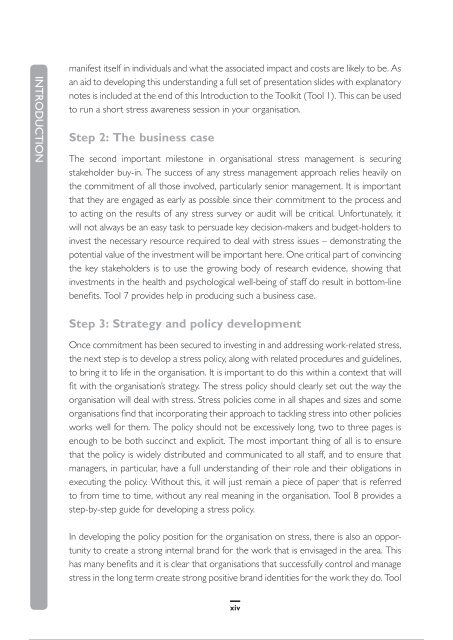Contents - CIPD
Contents - CIPD
Contents - CIPD
Create successful ePaper yourself
Turn your PDF publications into a flip-book with our unique Google optimized e-Paper software.
INTRODUCTIONmanifest itself in individuals and what the associated impact and costs are likely to be. Asan aid to developing this understanding a full set of presentation slides with explanatorynotes is included at the end of this Introduction to the Toolkit (Tool 1). This can be usedto run a short stress awareness session in your organisation.Step 2: The business caseThe second important milestone in organisational stress management is securingstakeholder buy-in. The success of any stress management approach relies heavily onthe commitment of all those involved, particularly senior management. It is importantthat they are engaged as early as possible since their commitment to the process andto acting on the results of any stress survey or audit will be critical. Unfortunately, itwill not always be an easy task to persuade key decision-makers and budget-holders toinvest the necessary resource required to deal with stress issues – demonstrating thepotential value of the investment will be important here. One critical part of convincingthe key stakeholders is to use the growing body of research evidence, showing thatinvestments in the health and psychological well-being of staff do result in bottom-linebenefits. Tool 7 provides help in producing such a business case.Step 3: Strategy and policy developmentOnce commitment has been secured to investing in and addressing work-related stress,the next step is to develop a stress policy, along with related procedures and guidelines,to bring it to life in the organisation. It is important to do this within a context that willfit with the organisation’s strategy. The stress policy should clearly set out the way theorganisation will deal with stress. Stress policies come in all shapes and sizes and someorganisations find that incorporating their approach to tackling stress into other policiesworks well for them. The policy should not be excessively long, two to three pages isenough to be both succinct and explicit. The most important thing of all is to ensurethat the policy is widely distributed and communicated to all staff, and to ensure thatmanagers, in particular, have a full understanding of their role and their obligations inexecuting the policy. Without this, it will just remain a piece of paper that is referredto from time to time, without any real meaning in the organisation. Tool 8 provides astep-by-step guide for developing a stress policy.In developing the policy position for the organisation on stress, there is also an opportunityto create a strong internal brand for the work that is envisaged in the area. Thishas many benefits and it is clear that organisations that successfully control and managestress in the long term create strong positive brand identities for the work they do. ToolxivA free sample chapter from Stress by Robertson Cooper. Published by the <strong>CIPD</strong>. © 2008 <strong>CIPD</strong>.All rights reserved; no part of this excerpt may be reproduced, stored in a retrieval system, or transmitted in anyform or by any means, electronic, mechanical, photocopying, recording or otherwise without the prior writtenpermission of the publishers or a licence permitting restricted copying in the United Kingdom issued by theCopyright Licensing Agency.If you would like to purchase this product please go to www.cipd.co.uk/bookstore
















